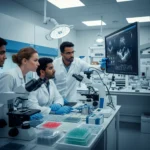Forget about needles, mysterious powders, and complicated cycles. Stem cell therapy is stepping up as the latest and greatest way to boost muscle growth and replace testosterone, promising impressive gains without the nasty side effects of traditional anabolic steroids. Let’s dive into this scientific wonderland and see how it can transform you into a muscle-bound marvel. If you’re thinking about getting Stem Cell Therapy treatment, Your Guide to Picking the Perfect Stem Cell Therapy Clinic might be useful. Or set up a conversation with our team here. They can guide you in deciding if it’s the right fit, help you choose the best clinic & region, and even assist you in securing some great discounts!
The Science Behind Stem Cells and Muscle Growth
Stem cells, particularly mesenchymal stem cells (MSCs) and induced pluripotent stem cells (iPSCs), are the real MVPs of the regenerative world. These little guys can morph into various cell types, including muscle cells, and are pros at calming inflammation. That makes them perfect for fixing and bulking up those biceps.
Induced Pluripotent Stem Cells (iPSCs): These overachievers can turn into any cell type, including those beefy muscle cells. They’re a bit like the stem cell world’s Swiss Army knife, useful for everything muscle-related. However, iPSCs can carry a risk of forming tumors, like teratomas, so it’s important to consider the risks and benefits.
Mesenchymal Stem Cells (MSCs): These are your best buddies found in umbilical cords, fat, and bone marrow. They turn into muscle cells and help repair and grow muscle tissues, perfect for anyone looking to add some serious muscle mass.
Making iPSCs Safer for Use
While iPSCs have incredible potential, scientists are aware of the risks and are actively working to make them safer for therapies. Here’s what they’re doing to reduce risks:
- Ensuring Full Differentiation: Researchers ensure iPSCs are fully differentiated into the desired cell type before they’re used in treatments. This process minimizes the chances of any undifferentiated cells causing problems.
- Genetic and Epigenetic Screening: To make iPSCs safer, scientists screen for genetic mutations and adjust epigenetic markers, helping keep these cells stable and effective.
- Using Safe Reprogramming Methods: By using non-integrative reprogramming methods, like mRNA or episomal vectors, researchers avoid permanent changes to the cells’ DNA, reducing potential risks.
- Employing CRISPR and Gene Editing: CRISPR technology allows scientists to edit out risky genes or add safety switches, which can be triggered to eliminate any problematic cells.
- Developing Immunotherapy and Safety Switches: Scientists are also designing immune cells to target and destroy any harmful cells and creating safety switches that can be activated if needed.
- Extensive Preclinical Testing and Monitoring: Before using iPSCs in humans, they undergo rigorous testing in animal models. Continuous monitoring of patients further ensures any issues are quickly identified and addressed.
With these advancements, the safety of iPSCs is improving, making them a promising option in regenerative medicine.
Gene Therapy and Follistatin: The Muscle Growth Dream Team
Combining stem cell therapy with gene editing is like giving your muscles a cheat code. Follistatin, a protein that tells myostatin (a pesky muscle growth inhibitor) to take a hike, is at the forefront of these innovations. By upping follistatin levels through gene therapy, researchers are seeing serious muscle growth and performance enhancements.
Clinical Evidence: Dr. Adeel Khan, a pioneer in regenerative medicine, highlights the jaw-dropping potential of follistatin gene therapy. Patients in clinical trials have shown massive improvements in muscle mass and strength. This therapy essentially puts muscle growth on the fast track by removing the natural brakes myostatin puts on your muscles.
Gene Therapy and Follistatin: The Muscle Growth Dream Team
Tired of the hormone rollercoaster? Stem cell therapy might just be your ticket to stable and natural testosterone levels. By encouraging your body to produce its own hormones, this therapy offers a sustainable and less invasive alternative to synthetic testosterone.
Luteinizing Hormone (LH) Gene Therapy: This cutting-edge approach uses gene therapy to boost luteinizing hormone production, which then stimulates your natural testosterone production. According to Dr. Khan, this therapy can shoot your testosterone levels into the upper range, providing all the anti-aging and performance perks without the side effects of synthetic hormones.
Practical Applications and Real-World Examples
Athletes and fitness buffs are already reaping the rewards of these innovative treatments. IV stem cell therapy, for instance, promotes anti-inflammatory effects and improves mitochondrial function, crucial for muscle performance and recovery.
Real-World Examples: Take world champion arm wrestler Deon Lett, who has reported significant performance boosts after undergoing follistatin gene therapy. Such anecdotal evidence, combined with solid clinical research, showcases the game-changing potential of these therapies.
Considerations for Gene Therapy & Stem Cell Therapy for Muscle Growth
While stem cell and gene therapy show incredible promise, there are a few points to keep in mind:
Comparing to Traditional Methods: It’s worth noting that while stem cell and gene therapies offer new avenues for treatment, they have different purposes and risks compared to traditional methods like anabolic steroids or synthetic testosterone. It’s all about finding the right fit for your needs.
Long-Term Studies Needed: While the early results are exciting, most clinical trials are still in the early stages. We need more long-term studies to understand the full range of benefits and any potential risks over time.
Tumor Risks with iPSCs: Using iPSCs can carry a risk of tumor formation. However, researchers are making significant strides to minimize this risk through advanced screening and safety measures.
Ethical and Regulatory Landscape: The use of stem cells and gene therapy varies widely across countries, and ethical considerations, especially regarding gene editing, play a crucial role. It’s important to consider these aspects and ensure that treatments comply with local regulations.
Variable Results and Standardization: The effectiveness of these therapies can vary from person to person. Plus, the field is still working toward standardizing treatments to ensure consistent outcomes.
Cost and Accessibility: Stem cell and gene therapies can be expensive and are often not covered by insurance. This could limit access for some people, so weighing the costs and benefits is key.
Anecdotal vs. Clinical Evidence: While many people have reported positive outcomes, much of the current support is anecdotal. It’s essential to balance these stories with peer-reviewed research to get a complete picture.
Conclusion
Stem cell therapy for muscle growth is emerging as a promising alternative to steroids and testosterone replacement, potentially revolutionizing muscle growth and hormone regulation. As research progresses, these therapies could become more mainstream, offering exciting new options for athletes and fitness enthusiasts. However, it’s important to consider the current limitations, ongoing research needs, and potential risks. Always consult with a medical professional to explore all your options and make informed decisions.
If you want to learn more about other conditions Stem Cells can treat, our article on What conditions can Stem Cell Therapy treat might be useful!
Imagine your body getting a VIP treatment! Here’s how it works: First, doctors harvest stem cells from your own body or obtain them from a donor. Technicians process and prepare these little superheroes in a lab. Once they’re ready for action, doctors inject them into the area that needs help—like a worn-out joint or a damaged organ. From there, the stem cells get to work, regenerating tissue and helping your body heal from the inside out. It’s like having your own personal repair crew on call!
The price depends on the treatment you choose and how sharp your negotiating skills are! Reach out to us here if you want to grab some cool discounts or need a hand on your journey
Yes, stem cell therapy is legal in the US, but the FDA enforces a bunch of rules. You can only use stem cells for certain approved treatments, like fixing blood disorders with hematopoietic stem cell transplants. The FDA bans lab-grown stem cells and limits their use to their intended jobs. So, while you can get stem cell therapy here, your options are more limited than in other places
Fill in your details below
For a discounted offer for Stem Cell Therapy!














